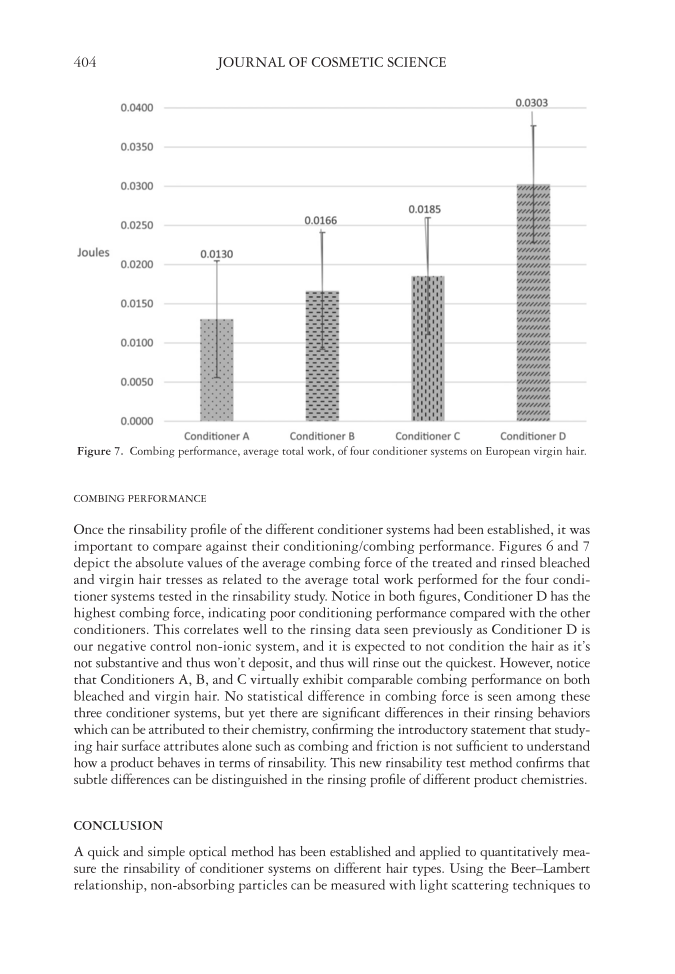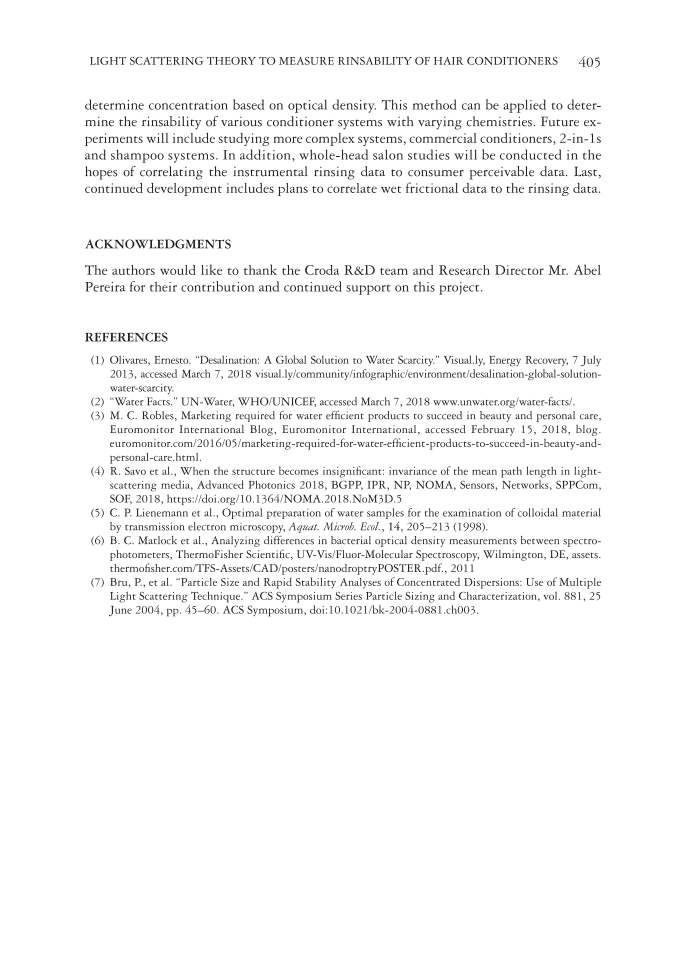JOURNAL OF COSMETIC SCIENCE 404 COMBING PERFORMANCE Once the rinsability profi le of the different conditioner systems had been established, it was important to compare against their conditioning/combing performance. Figures 6 and 7 depict the absolute values of the average combing force of the treated and rinsed bleached and virgin hair tresses as related to the average total work performed for the four condi- tioner systems tested in the rinsability study. Notice in both fi gures, Conditioner D has the highest combing force, indicating poor conditioning performance compared with the other conditioners. This correlates well to the rinsing data seen previously as Conditioner D is our negative control non-ionic system, and it is expected to not condition the hair as it’s not substantive and thus won’t deposit, and thus will rinse out the quickest. However, notice that Conditioners A, B, and C virtually exhibit comparable combing performance on both bleached and virgin hair. No statistical difference in combing force is seen among these three conditioner systems, but yet there are signifi cant differences in their rinsing behaviors which can be attributed to their chemistry, confi rming the introductory statement that study- ing hair surface attributes alone such as combing and friction is not suffi cient to understand how a product behaves in terms of rinsability. This new rinsability test method confi rms that subtle differences can be distinguished in the rinsing profi le of different product chemistries. CONCLUSION A quick and simple optical method has been established and applied to quantitatively mea- sure the rinsability of conditioner systems on different hair types. Using the Beer–Lambert relationship, non-absorbing particles can be measured with light scattering techniques to Figure 7. Combing performance, average total work, of four conditioner systems on European virgin hair.
LIGHT SCATTERING THEORY TO MEASURE RINSABILITY OF HAIR CONDITIONERS 405 determine concentration based on optical density. This method can be applied to deter- mine the rinsability of various conditioner systems with varying chemistries. Future ex- periments will include studying more complex systems, commercial conditioners, 2-in-1s and shampoo systems. In addition, whole-head salon studies will be conducted in the hopes of correlating the instrumental rinsing data to consumer perceivable data. Last, continued development includes plans to correlate wet frictional data to the rinsing data. ACKNOWLEDGMENTS The authors would like to thank the Croda R&D team and Research Director Mr. Abel Pereira for their contribution and continued support on this project. REFERENCES (1) Olivares, Ernesto. “Desalination: A Global Solution to Water Scarcity.” Visual.ly, Energy Recovery, 7 July 2013, accessed March 7, 2018 visual.ly/community/infographic/environment/desalination-global-solution- water-scarcity. (2) “Water Facts.” UN-Water, WHO/UNICEF, accessed March 7, 2018 www.unwater.org/water-facts/. (3) M . C. Robles, Marketing required for water effi cient products to succeed in beauty and personal care, Euromonitor International Blog, Euromonitor International, accessed February 15, 2018, blog. euromonitor.com/2016/05/marketing-required-for-water-effi cient-products-to-succeed-in-beauty-and- personal-care.html. (4) R. Savo et al., When the structure becomes insignifi cant: invariance of the mean path length in light- scattering media, Advanced Photonics 2018, BGPP, IPR, NP, NOMA, Sensors, Networks, SPPCom, SOF, 2018, https://doi.org/10.1364/NOMA.2018.NoM3D.5 (5) C . P. Lienemann et al., Optimal preparation of water samples for the examination of colloidal material by transmission electron microscopy, Aquat. Microb. Ecol., 14, 205–213 (1998). (6) B. C. Matlock et al., Analyzing differences in bacterial optical density measurements between spectro- photometers, ThermoFisher Scientifi c, UV-Vis/Fluor-Molecular Spectroscopy, Wilmington, DE, assets. thermofi sher.com/TFS-Assets/CAD/posters/nanodroptryPOSTER.pdf., 2011 (7) Bru, P., et al. “Particle Size and Rapid Stability Analyses of Concentrated Dispersions: Use of Multiple Light Scattering Technique.” ACS Symposium Series Particle Sizing and Characterization, vol. 881, 25 June 2004, pp. 45–60. ACS Symposium, doi:10.1021/bk-2004-0881.ch003.
Purchased for the exclusive use of nofirst nolast (unknown) From: SCC Media Library & Resource Center (library.scconline.org)









































































































